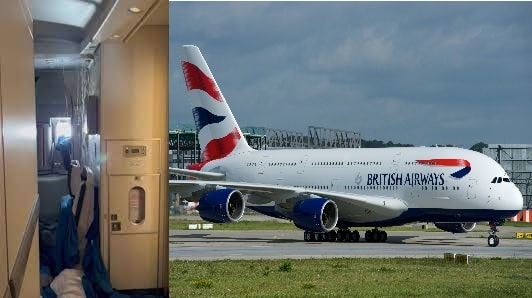Aerospace
British Airways’ Airbus A380 was filled with water during a flight from London to Washington.

A British Airways A380-800 narrowly escaped a severe accident on flight BA293. The plane had taken off from London and was on its way to Washington, D.C. when the lower deck began to fill with water from the top deck. The British Airways plane landed safely, relieving passengers, while brew members onboard worked to control the water flow. Crew members tried to stop the flow of water by soaking it up with towels and blankets. Additionally, the passengers on the plane who were stranded in the situation were moved to dry areas.
[the_ad id=”11602″]
A video of the incident was released on Twitter, showing water spilling from the steps leading up to the club world seats in the top class cabin. Moving forward, team personnel have clearly placed towels and blankets on the stairs to soak any surplus water. Water can also be seen coming in from the plane’s ceiling in the video.
British Airways A380 cabin fills with water from the upper deck during a flight between Heathrow to Washington DC. The aircraft continued for a safe landing in Washington. https://t.co/Kx7E0JlCX5 pic.twitter.com/UOv7LOflsC
— Breaking Aviation News & Videos (@aviationbrk) June 14, 2022
According to Sam Chui’s news report, a British Airways spokesman blamed the incident on a faulty valve on the aircraft’s internal clean water supply tank, which engineers fixed upon arrival in the United States. Furthermore, the airline’s agent stated that a detour was unnecessary because safety was not jeopardised.

Aerospace
Boeing Transfers Rocket Stage to NASA, Paving Way for Human Moon Mission

Boeing has achieved a significant milestone by providing NASA with the second core stage of the Space Launch System (SLS) rocket.
This crucial component, crafted at NASA’s Michoud Assembly Facility (MAF), is set to propel the Artemis II crew into lunar orbit, marking humanity’s return to deep space after a 50-year hiatus.
The monumental Boeing-built rocket stage, the largest element of the Artemis II mission, will embark on a journey aboard the Pegasus barge, traveling 900 miles to NASA’s Kennedy Space Center.
Comparison of two legendary aircraft B777x vs B747 aircraft:Click here
Upon arrival, it will be meticulously integrated with other essential Artemis II components, including the upper stage, solid rocket boosters, and NASA’s Orion spacecraft within the iconic Vehicle Assembly Building. This intricate integration process is a vital step toward the eagerly anticipated Artemis II launch, slated for 2025.
“Boeing-built products helped land humankind on the moon in 1969, and we’re proud to continue that legacy through the Artemis generation,” remarked Dave Dutcher, vice president and program manager for Boeing’s SLS program. “Together, with NASA and our industry partners and suppliers, we are building the world’s most capable rocket and paving the way to deep space through America’s rocket factory in New Orleans.”
NASA, Lockheed Martin Reveal X-59 Quiet Supersonic Aircraft:Click here
The delivery of Core Stage 2 marks a significant achievement in the evolution of the SLS rocket. Towering over 200 feet and powered by four RS-25 engines, this core stage, coupled with two solid-fueled booster rockets, will generate a staggering 8.8 million pounds of thrust. This immense power is crucial to launching Artemis II and future missions into the vast expanse of space.
The SLS rocket stands unparalleled in its capability to transport both crew and substantial cargo to the moon and beyond in a single launch. Its extraordinary capacity will facilitate the delivery of human-rated spacecraft, habitats, and scientific missions to destinations including the moon and Mars, ushering in a new era of space exploration.
-

 Travel1 week ago
Travel1 week agoAir India to Expand US Operations with Three New Routes After a Decade
-

 Travel2 weeks ago
Travel2 weeks agoWhy We Should Avoid These Stamps in a Passport
-

 Airlines1 month ago
Airlines1 month agoInvestigations Reveal Fake Chinese Titanium in Boeing and Airbus Jets
-

 Tech4 weeks ago
Tech4 weeks agoChina’s CATL Plans 1,800-Mile Electric Plane Launch by 2027
-

 Airport3 days ago
Airport3 days agoTop 10 Largest Airports in the World by Size
-

 Aerospace4 weeks ago
Aerospace4 weeks agoChina’s Fighter Jets Turn Wings into Autonomous Drones
-

 Airlines4 days ago
Airlines4 days agoAir India Rolls Out A350s for Delhi-New York JFK and Newark Routes
-

 Defence3 weeks ago
Defence3 weeks agoBoeing Enhances Chinook with New Engines and Block II Upgrades at $96 Million







